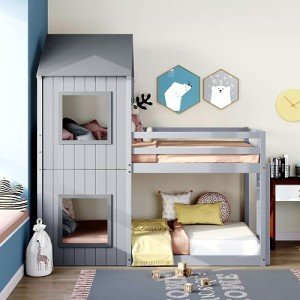12 Companies Are Leading The Way In Bunk Beds Children's
The Ultimate Guide to Bunk Beds for Children: Safety, Styles, and Benefits
When it concerns styling a child's space, moms and dads typically deal with the dual challenge of maximizing space while making sure comfort and functionality. Best Rated Bunk Beds julietlarson.top have actually emerged as a popular option that resolves these requirements, using not just sleeping arrangements but also contributing to a room's aesthetic. In this thorough guide, we will dig into different elements of kids's bunk beds, focusing on their benefits, security functions, styles, and factors to consider for parents contemplating this purchase.
Table of Contents
- Advantages of Bunk Beds
- Safety Features to Consider
- Types of Bunk Beds
- Design and Style Options
- Maintenance Tips
- Often Asked Questions (FAQs)
1. Advantages of Bunk Beds
Bunk beds provide various advantages for kids and their parents. Here are some crucial advantages:
Space-Efficiency: Bunk beds are an exceptional option for smaller sized rooms. By stacking one bed on top of another, more flooring space is readily available for play, storage, or study locations.
Economical: When kids share rooms, bunk beds can decrease the need for acquiring 2 separate beds, thus saving money.
Promotes Social Interaction: Bunk beds can assist siblings or friends bond by sharing a space, producing opportunities for social development.
Fun Factor: The concept of sleeping “up high” adds a playful element to bedtime, making the shift to sleeping alone easier for some children.
Versatile Design: Bunk beds are available in various styles, colors, and develops to match any space style, allowing for personalization that reflects the kid's character.
2. Safety Features to Consider
Safety is vital when it pertains to kids's furnishings, especially when it comes to bunk beds. Here are some critical security features to assess:
Safety Feature
Description
Durable Construction
Frames made from solid wood or metal are preferred.
Guardrails
Must be at least 5 inches high and extend along both sides of the upper bunk.
Ladder Design
Make sure ladders are safely connected and have non-slip actions.
Mattress Size & & Fit
Must fit comfortably within the frame to prevent spaces.
Weight Limit
Always adhere to the manufacturer's weight limitation suggestions.
3. Types of Bunk Beds
Bunk beds can be found in numerous designs, dealing with numerous requirements, preferences, and space sizes. Here are some common types:
Standard Bunk Bed: The the majority of standard type, with one bed on top of another.
Loft Bed: Features a high upper bed with space beneath for a desk or play area.
Futon Bunk Bed: Combines a leading bunk with a futon on the bottom, offering flexibility for seating and sleeping.
L-Shaped Bunk Bed: This design has the leading bunk set at a perpendicular angle to the bottom, developing a little corner location.
Triple Bunk Bed: Accommodates three children utilizing stacked beds, suitable for large households or sleepovers.
4. Style and Style Options
When it concerns selecting a style for children's bunk beds, the options are practically unlimited. Here are some popular designs:
Traditional Style: Often made from wood, these bunk beds feature elaborate information and are perfect for timeless or rustic-themed rooms.
Modern Style: Characterized by tidy lines and minimalist designs, modern bunk beds can be made of metal or wood.
Themed Bunk Beds: Some brands provide bunk beds formed like castles, cars and trucks, or play houses, making bedtime less of a task.
Convertible Bunk Beds: These can be separated into two private beds, providing flexibility as kids grow.
Colorful Options: Bunk beds in vibrant colors can add a sense of pleasure and playfulness to any room.
5. Upkeep Tips
Preserving a bunk bed is essential for longevity and safety. Here are some pointers:
Regular Inspections: Check for loose screws or bolts every couple of months and tighten them as needed.
Cleaning: Wipe down frames regularly to prevent dust build-up; consider utilizing a vacuum for hard-to-reach locations.
Mattress Care: Rotate bed mattress routinely and utilize protective covers to prolong their life.
Expect Wear and Tear: Look for any indications of damage in the wood or metal and consider changing parts if required.
Teach Kids Safety Rules: Encourage children to use ladders appropriately and guarantee they understand the safety features of their bed.
6. Regularly Asked Questions (FAQs)
Q1: What age is suitable for oversleeping a top bunk?
A1: Typically, kids aged 6 and older are advised for upper bunk sleeping, as they have the necessary motor abilities to climb safely.
Q2: Do bunk beds include a bed mattress?
A2: Most bunk beds are offered as frames only, so you will need to buy bed mattress individually. Guarantee that the mattress fits the frame snugly.
Q3: Can bunk beds be separated later?
A3: Many styles permit conversion into two specific beds, supplying versatility for future needs.
Q4: How can I ensure my child's security on a bunk bed?
A4: Comply with security requirements and make sure guardrails, a sturdy frame, and a secured ladder remain in location.
Q5: Are there weight limitations on bunk beds?
A5: Yes, always examine the maker's requirements concerning weight limits to guarantee security.
Bunk beds for kids can serve multiple purposes while ensuring safety and style. With varied styles and designs available on the market, parents can find a system that not only takes full advantage of bedroom space however likewise shows their child's distinct tastes. Similar to any furniture, understanding security functions, upkeep, and how they suit a kid's lifestyle will ensure that these beds remain a useful furniture solution for years to come.
Through cautious consideration and adherence to safety standards, bunk beds can provide a long-lasting, fun, and practical sleeping solution that children enjoy.
